Assessment and Mapping of Vulnerable Roads to Accidents Through Geospatial Techniques
IqraBano1*, NasirAbbas1, Sadaf Ali Abbas1, Muhammad Abubakar3, Raheema Elahi1, Fatima Akhtar2
1 Geography Department, Government College University of Lahore
2 Department of Space Science Department, University of the Punjab
3 State Key Laboratory of Information Engineering in Surveying, Mapping and Remote Sensing
(LIESMARS), Wuhan University, Wuhan 430079, China
* Correspondence: Iqra Bano banoiqra1@gmail.com
Citation | Bano I, Mirza I.A, Abbas.N , Abbas.S.A, Abubakar.M, Elahi.R, Akhtar.F “Assessment and
Mapping of Vulnerable Roads to Accidents through Geospatial Techniques” International Journal of
Innovations in Science & Technology, Vol 02 Issue 04: pp 195-201, 2020.
Received | Nov 18, 2020; Revised |Dec 10, 2020 Accepted | Dec 14, 2020; Published | Dec
18, 2020.
An Pakistan, about 36000 people were killed in road accidents in the year 2019. This study focuses on
hazard assessment through geo-spatial techniques using both quantitative and qualitative research
methodologies. An attempt was made to demarcate the most vulnerable roads to accidents for the years 2015 to 2019 through geospatial techniques. The data used in this research was collected through real time field observation using questionnaire-based survey. The results show that the ratio of reported accidents was higher in 2019 which was 53,979, in comparison to the number of accidents occurred in 2015 which were 19,073. It caused 478 casualities in 2019 in comparison to 308 in 2015. We found various reasons behind these accidents at both administration and individual levels e.g., about 67% increase was observed in number of vehicles from 2015 to 2019 whereas only 14% driving licenses were issues against this number. The most vulnerable roads where most of accidents occurred were Ferozepur Road, Ring Road, Mall Road and Jail Road whereas, in Iqbal Town, the roads were Canal Road, Multan Road, College Road and Raiwind Road. Geospatial techniques proved efficient for mapping the vulnerable roads to accidents.
Keywords: Road Traffic Accident (RTA), Two Wheelers, Vulnerable Roads, Hazards, Driving
licenses.
Introduction
Road traffic accident is a term specified by Economic Commission for Europe (ECE); i.e., traffic accidents which occur in a way that cause deaths or injuries, where at least one vehicle is involved [1]. Accidents can be categorized in four types, i.e., fatal, non-fatal, slight, and property damage [2]. The fatal accident leads to the death of more than one person and the other type of accident is non-fatal which leads to serious injuries including fractures, unconsciousness, inner cuts, scratches and grazes etc. Third type of accident is concerned with damages and the fourth type of accident is related to property/infrastructures damages[3].
Around 1.35 million people were killed in road accidents globally in 2019 according to WHO[4] and 50 millions are disabled or injured. Approximately 3000 people die in the traffic accidents every day [4]. Traffic accidents have become a fundamental cause of death for young people of age group (15-19) years due to immaturity and nonawareness of traffic laws. Accidents are projected to be the 5th leading cause of death for all age groups globally by the year 2030 [5].
A total 1 % to 3 % of Gross National Product (GNP) is lost globally, particularly in low and middle-income countries, approximating to 500B$. About 90% of total Road Traffic Accident (RTA) leads to causalities which mostly occur in middle and low-income countries. Accidental deaths have been decline by 30% in developed countries due to awareness and implication of traffic laws [5].
The magnitudes of high-risk road accidents are greater in middle and low-income countries [4]. World Health Organization (WHO) published a special report about road accident in Pakistan which described that 27,871 causalities occurred in the year 2019 and the death rate was computed as 15.42 per 100,000 of population [4]. Pakistan occupies number 104 in accident hazards in the world [4]. In Pakistan, it is estimated that around 40000 people die in accidents every year, and many other face serious injuries [6]. According to Rescue 1122 department, two-thirds of people driving on roads, die every year due to road traffic crashes RTCs in major and minor road accidents. According to recent survey reports, around 15-17 per 1000 persons die per year in
Pakistan [7]. A researcher revealed that most of the accidental injuries were recorded to the age
group ranging between 16 and 30 years [8].
According to 2019 Statistics Report, 443 people lost their lives, 54,240 people were injured and 53,979 road accidents occurred in Lahore [9]. Reasons behind most of accidents were careless driving, over-speeding and nonawareness of traffic laws. Actual facts regarding accidents differ from rescue 1122 reports because most of victims hide their identity from media [9]. Mostly lower class and backward localities are observed under accidents which result to indulge many families further into poverty by the loss of their bread and butter [10].
The main objective of this study was to analyze the major causes of increasing number of accidents reported each day in the study site. It also aim at investigating the reasons behind these accidents and to suggest appropriate solutions for preventions from these unpleasant events.
Material and Methods
Investigation site
This research was carried out in the Lahore’s two major towns, Data Ganj Bakhsh town and Iqbal town. Data Ganj Bakhsh is situated in the center of Lahore. This town is spatially located at 31°34' N latitude & 74°18’ E longitude. Iqbal town is a residential/commercial area of Lahore, situated in the south west of Lahore region with spatial location 31°30’N latitude and 75°17’E longitude.
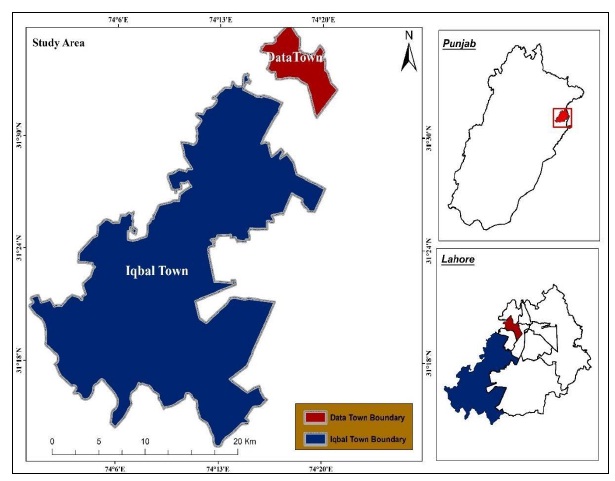
Figure 1: Study Area, Data Ganj Bakhsh & Iqbal Town
Data Analysis 1122 Report, Vehicles, Population & Online Field Survey, GPS Survey & Questionnaires Statistical Spatial Research Objectives Achieved Assessment of Accident Hazard in Data Gunj Bakhsh Town and Iqbal Town Mean, Median, Standard Deviation Simply Categorized Vulnerable Roads
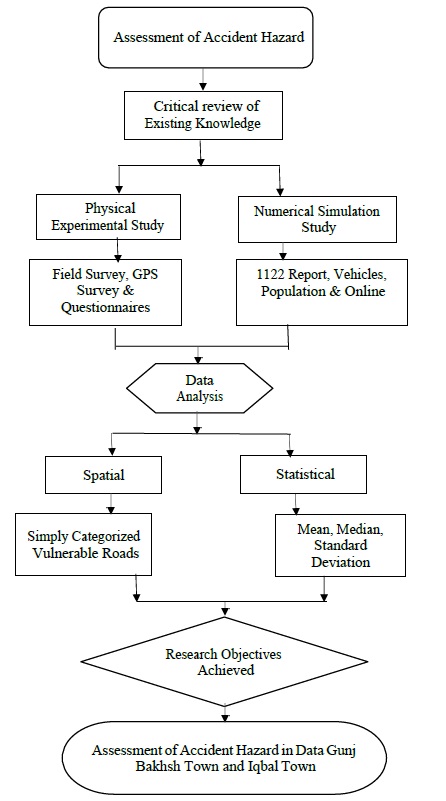
Figure 2: Flow of Methodology In this study, the primary source of data was questionnaire-based field survey conducted within the study site. The secondary source of data was number of major and minor accidents reported in various hospitals and police stations from 2015 to 2019. Data of vehicle registration Numerical Simulation Study Physical Experimental Study Critical review of Existing Knowledge Assessment of Accident Hazard was obtained from excise and taxation office. In data analysis, multiscale vulnerability was conducted of accidents in Data Ganj Bakhsh and Iqbal Town.
Results and Discussion.
The roads vulnerable to accidents were mapped by distinguishing their categories in Figure 3.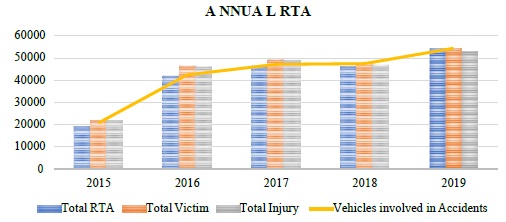
Figure 3. Yearly growth of Road Traffic Accidents (2015-2019)
source: Rescue 1122 control office
Figure 3 shows that the highest number of accidents occurred in 2019 while lowest were observed in 2015. It means that the accidents were increased with respect to space and time. In 2019, there were 53,979 number of the accidents, 54,240 number of victims, 52,856 number of injuries and 54,345 vehicles involved in accidents. While in 2015, there were 19,073 number of accidents, 21,794 number of victims, 21,719 number of injuries and 20,721 number of vehicles involved in accidents. The trend of yearly increase in road traffic accidents within last five years was observed 3 time more in 2019 as compare to 2015. In 2015, Rescue 1122 department was with lack of equipment, technology, ambulances and skilled workers that’s why the number of cases
was also limited.
Table 1. Annual increase in Road Traffic Accidents (RTA)

Figure 4: Yearly increase of vehicles in Lahore (Source: Excise & Taxation Office of Punjab)
Figure 4 shows that 1.83 million vehicles were registered in 2019 comparison to 1.23 million in 2015. The percentage of increase in vehicle’s registration was about 14.81% within 5 years from 2014 to 2019. It may be dramatic increase in the vehicles due to bank financing and rapid growth rate of population in Lahore metropolitan. This vehicle’s population was mainly increased by migrants of rural areas and the increase in population is directly linked with transportation facilities.

Figure 5: Deaths by Road Traffic Accidents, source: Rescue 1122 control office Figure 5 shows a comparison of deaths occurred in 2015 and 2019. In 2015, there were 308 people died in road accidents as compared to 478 in 2019. It was about 32% increase to deaths in comparison to previous years.
Table. 2 Total Deaths in Road Traffic Accidents (2015-2019)

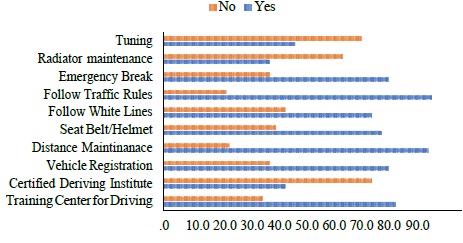
Figure 6: Awareness about various traffic related issues Questionnaire results are drawn in Figure 6, which is showing that 31% of respondents were aware of all matters related to vehicle’s maintenance. About 29% of respondents were familiar about tuning, 23% were aware of the radiator’s maintenance and only 7% knew about the maintenance of smoky vehicles. About 81% of respondents are aware of traffic rules and regulations. Whereas the rest 19% of respondents were involved in signal breaking and various types of other violations. About 70% respondents were trained from various training centers before getting driving license. On the other hand, rest 30% never visited any institution due to non-availability of training institutes and claimed that they know everything.
About 63% of respondents got driving license without any test from a recognized institution. They seem to use links or unfair means to get a license which was quite alarming situation. Only 37% of respondents were found properly certified from institutions. About 68% vehicles were registered properly on owner’s names and rest 32% of respondents did not bother to transfer vehicles in their names properly. They even did not carry their documents with them.
The awareness of maintaining a safe distance is important in driving. About 80% respondents claimed that they maintain a safe distance while driving and they know about the severity and prefer to maintain distance in order to avoid blocking/accident. Whereas, the rest 20% respondents were unaware of this kind of safety measures. About 66% of respondents claimed that they were familiar with the use of helmet/seat
belts. They knew that such negligence results in major accidents. Whereas, the rest 34% of the
respondents were not familiar with wearing of helmet/seat belts and they never considered it
compulsory.
Awareness of White Road Lines
About 63% of respondents claimed that they follow white lines and broken lines during driving. They had proper knowledge about lanes and variations in speed according to lane. They knew about the importance of lane in smooth driving which leads to eliminate accidents. The people who did not follow these lines were 37%. They claimed that they never use or follow paved lines and drive in a zigzag manner without following any rules.
Awareness About Emergency Break
About 68% of respondents claimed that they know how to stop their vehicle in an emergency situation. They were aware of controlling their vehicles in order to prevent further loss.
Whereas, the rest 32% of respondents claimed that they cannot handle their vehicles and are not
able to stop in any kind of emergency.
Major Roads Vulnerable to Accidents
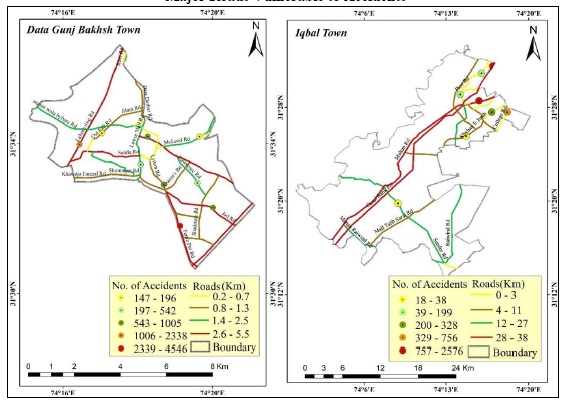
Figure 7: Vulnerable zone along major roads Data Gunj Bakhsh Town and Iqbal Town
Figure 7 is showing the spatial distribution of road network in the study site. The roads were categories on the basis of road length/width in kilometer/meters respectively. As per length, some roads were called major and some were minor roads. The major roads were observed with large number of accidents in comparison to minor roads as shown in Figure 7. The main reason of increasing number of accidents was mainly carelessness of individuals. People show immature behaviour while driving by competing their buddies on major roads and try to leave them behind while chasing each other. The overall situation results in over speeding which leads to sever accidents. About 80% people have proper awareness of traffic laws but they violate and the law
enforcement agencies seems to get fail for imposition of these rules to residents.
Conclusion.
This study reveal that traffic accidents have been increased in most populated areas of Lahore due to increase in population. The situation is getting drastic day by day but it is not due to capability/capacity of road infrastructure or unawareness of people, but a lack of controlling/ law enforcement was observed. Intentional violations of traffic laws by people occur but law enforcement agencies seem to be helpless for imposing traffic laws. Government need to introduce strong technical/technological equipment on roads to avoid violations of traffic laws. Challan system must be monitored and license cancellation must be imposed to culprits.
Acknowledgement. We are thankful to Rescue 1122 Lahore and Excise and taxation office
Lahore for providing their important information to accomplish this research.
Conflict of interest. Authors have no conflict of interest for publishing this manuscript in
IJIST.
References
1. Y. Debebe, "Road traffic accidents and human security in Addis Ababa," Master's Thesis,
vol. 1, pp. 6-8, 2014
2. B. Dadashovaa, B. Arenas-Ramírez, J. Mira-McWilliams and F. Aparicio-Izquierdo,
"Methodological development for selection of significant predictors explaining fatal road
accidents," Accident Analysis and Prevention, pp. 82-95, 2016.
3. M. A. H. Talpur, I. A. Chandio and M. N. T. H. Ali, "Comparative Accidental Analysis of
N-55 Jamshoro-Manjhand Section, Sindh, Pakistan," Sindh University Research Journal-SURJ
(Science Series), vol. 49, no. 1, pp. 2-5, 2017.
4. WHO., "Facts on global road safety & Road traffic injuries.," World Health Organization,
Geneva., vol. 10, pp. 5-6, 2019.
5. B. P. Y. Loo and T. K. Anderson, "Spatial analysis Methods of Road Traffic Collisions,"
New York: CRC Press, 2015.
6. M. Tahir, G. Macassa, A. Akbar, R. Naseer, A. Zia and S. Khan, "Road traffic crashes in
Ramadan: an observational study," EMHJ, pp. 147-51, 2013
7. J. A. Bhatti, J. A. Razzak, E. Lagarde and L.-R. Salmi, "Differences in police, ambulance
and emergency department reporting of traffic injuries on Karachi-Hala road, Pakistan,"
Public Health, vol. 118, p. 211–217, 2011.
8. A. Ghaffar, A. A. Hyder and T. Masud, "The burden of road traffic injuries in developing
countries: the 1st National Injury Survey of Pakistan," Public Health, vol. 118, pp. 211-217,
2004.
9. F. Zaidi, "Daily Road Traffic Crashes Report," Rescue 1122, Lahore, 2019.
10. M. Talha.K, "Traffic accidents show no sign of slowing down," The Express Tribune,
Lahore, 2017.
11. C. S. RASUL, "Punjab Development Statistics," Statistical Bureau of Punjab Pakistan,
Lahore, 2019.
12. F. Ounia and M. Belloumia, "Spatio-temporal pattern of vulnerable road user’s collisions
hot spots and related risk factors for injury severity in Tunisia.," Transportation research part
F: traffic psychology and behaviour, vol. 56, pp. 477-495, 2018.




















